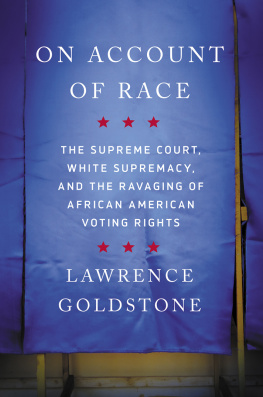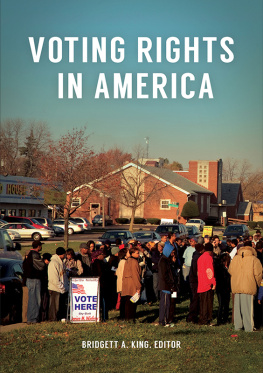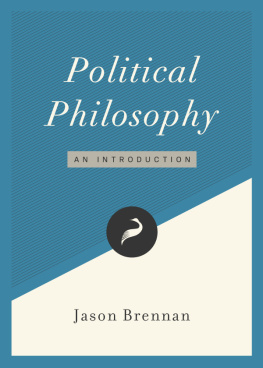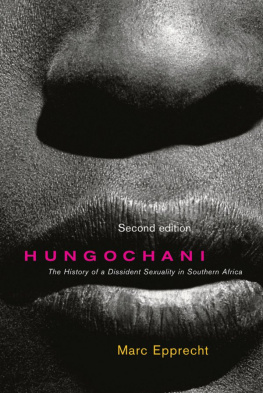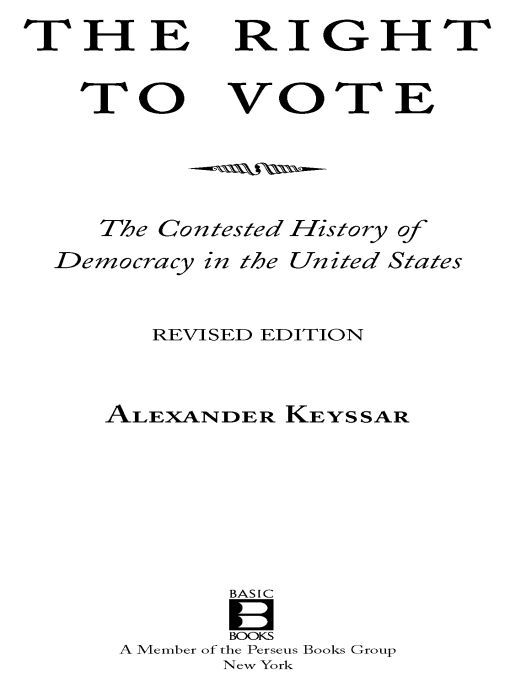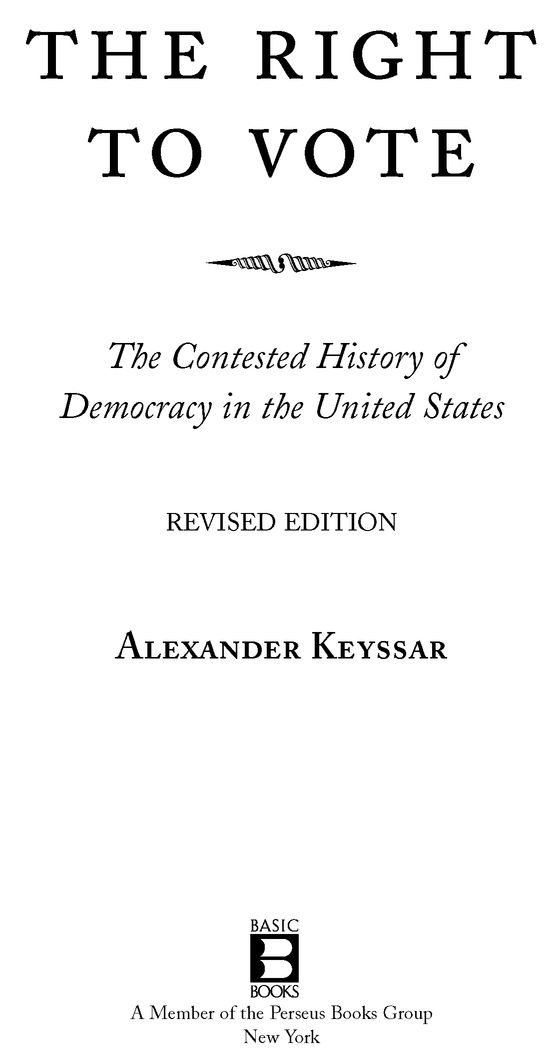Table of Contents
List of Tables
For Natalie
Preface to the Revised Edition
THE RIGHT TO VOTE WAS FIRST PUBLISHED in September 2000almost exactly two months before the prolonged and disputed presidential election that installed George W. Bush in the White House. That accident of timing brought to the book a degree of attention that it otherwise would not have received: not only did the right to vote rapidly (if temporarily) become everyones favorite right, but some of the issues and problems that surfaced in November 2000 were directly tied to developments chronicled in The Right to Vote. For the author of a historical study that began in the late eighteenth century, it was, of course, gratifying to be relevant to a contemporary crisiseven if that gratification came at some cost to the nation.
The 2000 election also kicked off an eventful period in the history of voting and voting rights in the United States. The election controversy itself raised pressing questions about the reliability of voting technology, the partisanship of election officials, the right of individuals to have their votes counted, the lifetime disfranchisement of felons, the Electoral College, and the relationship between state and federal authorities in conducting elections. (That list is not exhaustive.) In the aftermath of the election, state governments tackled some of these problems (as well as others linked to the administration of elections), and Congress weighed in with the Help America Vote Act in 2002. Several years later, Congress also reauthorized key portions of the landmark Voting Rights Act, which had first been enacted in 1965. Meanwhile, the courts continued to wrestle with issues of districting and minority representation, and in 2008 the Supreme Court gave its approval to strict, new identification requirements for voters. These years, in addition, witnessed heated election campaigns in which Democrats were repeatedly accused of vote fraud, while Republicans were charged with suppressing the rights of legitimate voters.
It was the richness and complexity of these eventsand not simply the passage of timethat led me to the decision to prepare a new edition of The Right to Vote. Or, to state the matter somewhat differently, a lot of history happened in the near-decade after the books original publication. That historyalthough very recentinvited examination; it also seemed best understood against the backdrop of the story already recounted in The Right to Vote. Indeed, the major developments of the years between 2000 and 2008 seemed both to illustrate critical themes of the book and to offer the opportunity to deepen the analysis by extending it to the present. The notion that political rights in the United States have always been contested, for example, seemed as applicable to the early twenty-first century as it did to the nineteenth; yet that very continuity invited further inquiry, given the numerous, significant changes that had occurred in institutional and political context.
The present volume, then, is less a revised edition than an updated or extended one. The first seven chapters of the book remain largely as they were in the original edition. I have, for the most part, resisted the temptation to tinker with the prosealthough, like any author, I can now spot a great many sentences where I might have said things better (or at least differently). I have added a few discussions of subjects that were somehow (!) omitted from the original edition (such as the Electoral College), and I have broadened or reshaped several interpretations (regarding felon disfranchisement, for example) to take into account the findings of persuasive new research. I have also inserted a missing item in one table () and updated numerous endnotes to incorporate relevant work that has been published in the last nine years.
But the great bulk of what is new in this volume deals with the years from 2000 to 2008. Chapter 9 focuses entirely on that period, tracing key developments from November 2000 to the election of Barack Obama in 2008. Where conceptually and stylistically appropriate, some post-2000 material has been integrated into a revamped version of Chapter 8 (which explored the evolution of voting rights from the 1950s through the 1990s): the renewal of the Voting Rights Act in 2006, for example, is examined in Chapter 8, directly following discussions of the renewals of 1970, 1975, and 1982. I have, in addition, recast some of the analyses in Chapter 8 in light of events that occurred after 1999. Changes in perspective and in my own thinking have also yielded modifications to the conclusion: some things do look a bit different in 2009 than they did in 1999.
Preparing this new edition has made me acutely aware of the distinctive intellectual challenges and hazards of writing historically about the very recent past. I believed, at first, that chronicling the years from 2000 to 2008 would be relatively easybecause the events were all known to me, I had watched them unfold, I knew some of the actors, and, in a few instances, I had even been a minor participant. But, in fact, the opposite was true. Proximity complicated the process of selection, weighting, and balancing that is always at the heart of the historians task. (The late Herbert Gutman, an important and witty social historian, once commented that the key to writing good history was knowing what to leave out; it is particularly difficult to leave out things that loomed so important just three years or three months ago.) I have tried to meet this challenge by imagining how a historian would view this period twenty or forty years from now, and by simultaneously conceiving of this era as an outgrowth of the long history of voting rights that preceded it. Whether I have succeeded in this effort is for others to judge, but I surely have learned a great deal by wrestling with the challenge.

Bringing this project to fruition was not a one-person operation, and I would like to thank those who helped me. The Ash Institute for Democratic Governance and Innovation, as well as the Office of the Dean at Harvards Kennedy School of Government, provided funding for the research; that funding permitted me to purchase hours of energetic information-gathering from Kenneth Weisbrode, Michael Sellitto, Meghan Cleary, Lisette Enumah, Robert King, Jonathan Warsh, and Elnigar Iltebir.
My agent, Andrew Wylie, encouraged this new edition from the beginning. William Frucht (then at Basic Books) offered sound editorial advice; subsequent editors Lara Heimert, Alix Sleight, and Sandra Beris ably navigated the manuscript through production. Early on, John Bonifaz, Heather Gerken, and Richard Pildes helped me to think about what ought to be included in a chronicle of the recent period. Tova Wang, Heather Gerken, Jason Karlawish, and Ellen Theisen all read portions of the manuscript and responded patiently to my questions, saving me from errors of fact and interpretation.
I would like to offer special thanks to Kathleen Schnaidt, who worked tirelessly (and with great aplomb and humor) to help me prepare the final manuscript, check (and obsessively re-check) endnotes, plug holes in the research, and navigate the sometimes clumsy process of integrating new prose into old electronic files. My colleague, Ernest May, has for years (both in the classrooms where we taught together and at our favorite Indian restaurant) generously shared his wisdom about the craft of history and its articulation with the recent past. My wife, Rosabelli, does not yet have the right to vote in American elections, but, before long, she will, and meanwhile, for everything,


